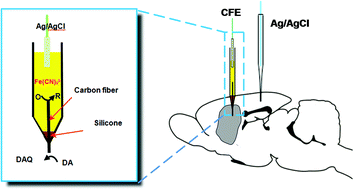Ferricyanide-backfilled cylindrical carbon fiber microelectrodes for in vivo analysis with high stability and low polarized potential
Abstract
The development of stable and reproducible methods for in vivo electrochemical monitoring of neurochemicals is of great physiological importance. In this study, we demonstrate ferricyanide-filled cylindrical carbon fiber microelectrodes (CFEs) of high stability and low polarized potential for in vivo electrochemical analysis. We first studied the voltammetric behavior of cylindrical CFEs by using a model system consisting of two separated cells each containing potassium ferricyanide (K3Fe(CN)6) or potassium ferrocyanide (K4Fe(CN)6). We observed that E1/2 values of the system were dependent on the ratio of the lengths of the cylindrical CFEs and of the concentrations of the redox species on both poles. Based on this property, we prepared the ferricyanide-backfilled cylindrical CFEs, and found that this kind of electrode exhibits a more stable current response and a lower polarized potential than the CFEs backfilled with KCl or Ru(NH3)6Cl3. Animal experiments with the ferricyanide-backfilled cylindrical CFEs demonstrate that this kind of electrode could be used for in vivo monitoring of neurochemical release with a high stability under some physiological conditions.


 Please wait while we load your content...
Please wait while we load your content...